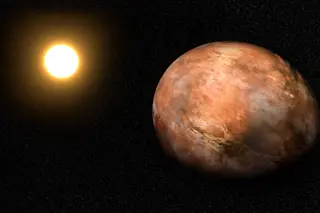It’s 7:47 in the evening. I’m sitting in my apartment, getting wasted, and I’m about to fly the space shuttle. Fortunately for NASA (and anyone who lives near Cape Canaveral), it’s a virtual shuttle.
When most people heard about the recent report suggesting that astronauts have flown under the influence, I’m sure they worried about NASA’s culture, the procedures of spaceflight, and the idea of putting multibillion-dollar pieces of hardware into the hands of boozehounds. Not me: My first thought was “How sober do you need to be to fly the shuttle, anyway?” We’ve sent dogs, monkeys, spiders, and even fruit flies into space, so how hard can it be?
Armed with champagne, a Breathalyzer, my trusty drinking buddy/copilot Marya Glur, and the most realistic computer simulation of the space shuttle we could find, I set out to find the answer.
Half an hour before we strapped ourselves in, metaphorically speaking, we downed a bottle of Pierre Peters Brut 1998. We chose champagne, not just to pad our expense account but because the carbon dioxide in the bubbles facilitates the absorption of alcohol into the bloodstream, producing impairment much more quickly than other forms of booze. Honest.
I blow into the Breathalyzer. My blood alcohol concentration (BAC) is .03. According to the handy-dandy leaflet that came with the Breathalyzer, a BAC of .03 means “no loss of coordination, slight euphoria, and loss of shyness. Depressant effects are not apparent.”
This would probably be the case even in orbit. David Robertson, director of the Vanderbilt Center for Space Physiology and Medicine at Vanderbilt University, speculates that while there are no experimental data, he would not anticipate any significant difference in the absorption of alcohol into the body in space.
Confident that my physiological state is now not materially different from that of an astronaut who had knocked back a few, Marya and I begin the simulation. It begins 1 hour and 39 minutes before liftoff and ends at “negative return”—the point at which the mission can no longer be aborted without going into space, some 4 minutes after launch. Copilot Marya calls out instructions from the prelaunch checklist. “Set XMIT ICOM to VOX/VOX. Set both A/G, A/A, and ICOM to T/R,” and so on. There are hundreds of switches, spread over multiple panels located left, right, center, overhead, and aft. And they don’t all just turn on and off—some have a midswitch position.
It takes some concentration, but at two minutes to launch, I set “APU AUTO SHUTDOWN 1/2/3” to “INHIBIT” and wait for liftoff. From this point on, there’s nothing to do; mission control does the heavy lifting. We have liftoff, and there’s still nothing to do but check some displays until we reach negative return and halt the simulation.
I take a BAC reading. The launch procedure was so long, my level dropped to .02. More drink is clearly required. The champagne is gone, so in honor of our mission, Marya and I mix Tang cocktails. Tang and vodka is appalling, and we can hardly get it down. Tang and rum? Unspeakably awful. But these failed attempts at mixology do manage to get my BAC up to .08. I am now legally drunk in all 50 states. We reset the simulation and start again.
An hour and 43 minutes later, Marya and I turn to each other, horrified. Here we are, safely at negative return, but this time running through the checklist was much easier and faster, despite our being significantly drunker. Apparently repetition trumps inebriation.
More Tang cocktails. Soon I am registering a BAC of .14: “Gross motor impairment and lack of physical control. Blurred vision and major loss of balance. Euphoria is reduced, and dysphoria is beginning to appear.” Roger that—I am no longer having fun. But science must prevail, so we restart once more. This time the letters are swimming before my eyes, and Marya has to repeat several of the commands. We have liftoff, but it’s not pretty.
My BAC has now reached .20. We try one more time, and suffering from what Marya calls space sickness, I fail to complete the simulation. My experiment is over: You don’t have to be stone-cold sober to fly the shuttle. In fact, you can be downright wasted. Or can you?
Former space shuttle commander Rick Searfoss bursts my champagne bubble. Searfoss piloted two shuttle missions and commanded a third. He agrees the launch sequence is simple. “A monkey could do it” if—and this is a big if—nothing goes wrong. The official NASA launch checklist is 225 pages long. The checklist I used was nine pages. The difference is over 200 pages of abort procedures. Searfoss estimates that only about 5 percent of a commander’s launch training is running through normal sequences—the rest of the time is spent learning how to cope with emergencies. My computer simulation, as detailed as it was, didn’t throw any curveballs, while in Searfoss’s training, “you die in the simulator all the time.” I also wasn’t wearing a heavy space suit with bulky gloves. Flipping an overhead switch in such a suit requires a great deal more effort and coordination than running a mouse around a computer screen.
Conclusion: We do not want our astronauts drinking. Just as important, I never want to see another Tang cocktail as long as I live.














